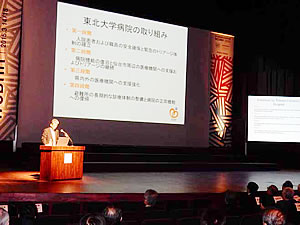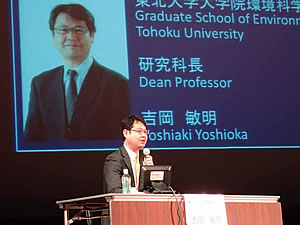The Great East Japan Earthquake Forum
At the Great East Japan Earthquake Forum, we invited celebrated speakers from home and abroad to offer insights into new and better reconstruction techniques in the field of disaster risk reduction.
Ten sessions were held over five days at the Tohoku University Centennial Hall (Hagi Hall) on the theme of “Sharing Our Experiences and Lessons of the Great East Japan Earthquake with the World.”
Members of Tohoku University – including President Susumu Satomi – played an active role in these sessions.
Sendai Medical Forum
■ Date and Time: Sunday, March 15 (10:00 – 12:00, reception from 9:00)
■ Hosted by: Sendai City Healthcare Department
Event Report
Part 1 – Panel Discussion

Keynote speech
Theme: A review of medical relief and public health maintenance after the Great East Japan Earthquake and recommendations for future activities
Moderator: Ichiro Tsuji (Professor, Tohoku University School of Medicine)
Panelists:
- Yukio Nagai (Chairperson, Sendai Medical Association)
- Junichi Osada (Chairperson, Sendai Dental Association)
- Tetsuji Kitamura (Sendai City Pharmacist Association)
Commentator : Takashi Kitaba (Head of regional medical planning, Health Policy Bureau, Ministry of Health, Labour and Welfare)
In a discussion moderated by Professor Ichiro Tsuji of the School of Medicine, panelists from the Sendai Medical Association, Sendai Dental Association and Sendai City Pharmaceutical Association discussed healthcare strategies in times of disaster. They drew on their own experiences and lessons learnt from the Great East Japan Earthquake, including the need for medical activities in evacuation shelters.
Part Two: Keynote Speech by Tohoku University President Susumu Satomi
Theme: Tohoku University Hospital’s medical activities in times of disaster
The university president – himself a surgeon and medical expert – outlined Tohoku University’s current and future plans to support the reconstruction of disaster-affected areas in the Tohoku region.
Revival from the Great East Japan Earthquake and the Way Forward
■ Date & Time: Monday, March 16, 15:00 – 18:00 (Reception from 14:30)
■ Hosted by: Ministry of Education, Culture, Sports, Science & Technology, Japanese National Commission for UNESCO, Miyagi University of Education
■ Co-hosted by: Tohoku University International Research Institute of Disaster Science, Japan Disaster Education Network Liaison for UNWCDRR
■ Supported by: Iwate Prefecture Board of Education, Miyagi Prefecture Board of Education, Fukushima Prefecture Board of Education, Sendai City Board of Education, Kesennuma City, Kahoku Shimpo Publishing Co.
Opening Speech
Yoshio Yamawaki, (Director-General for International Affairs, Ministry of Education, Culture, Sports, Science and Technology)
Panel Discussion
Theme: Revival from the Great East Japan Earthquake and the Way Forward.
Moderator: Professor Rajib Shaw (Kyoto University Graduate School of Environmental Studies, Chairman of SEEDS Asia)
Panelists:
- Alexander Leicht (Chief of Section, ESD, UNESCO)
- Amor Q. de Torres (VP for Academic Affairs, Capitol University in the Philippines)
- Fumihiko Imamura (Director, Tohoku University International Research Institute of Disaster Science)
- Akihiko Sugawara (Head, Kesennuma City Chamber of Commerce, member of Sendai ESD/RCE management team)
- Shinichi Takeda (VP, Kohoku Shimpo Publishing Co Editorial Committee)
Commentators:
- Hans van Ginkel (former Undersecretary-General of the United Nations, former Rector of the United Nations University)
- Suvendrini Kakuchi (President,Foreign Correspondents’ Club of Japan, correspondent for Inter Press Service,)
Event Report
This session on disaster reduction education was hosted by Japan’s Ministry of Education, Culture, Sports, Science and Technology and other related organizations.
Participants considered the role of Education for Sustainable Development (ESD) on disaster reduction and mitigation, and the impact of the Aichi-Nagoya Declaration that was adopted at the UNESCO World Conference on ESD in November 2014. To promote the effectiveness of ESD on disaster reduction and mitigation, case studies from several universities, the Hashikami district of Kesennuma City and Miyagi Prefecture’s Tagajo High school were introduced.
Among the participants was the Director of Tohoku University’s International Research Institute of Disaster Science, Fumihiko Imamura. Students from many elementary and junior high schools were also at the forum, listening from the audience with their parents.
Disaster waste management at the time of huge disaster:
Preparations and rapid recovery through public-private partnerships
■ Date & Time: Tuesday, March 17, 14:30 – 18:00, (Reception from 13:30)
■ Hosted by: Sendai City Disaster Waste Management Forum Committee
Case Studies
Disaster Waste Management at the time of the Great East Japan Earthquake
- Tsutomu Fukamatsu (VP, Sendai General Construction Association)
- Masayuki Sato (President, Miyagi Dismantling Contractors Cooperative)
- Noboru Suzuki (Sendai Branch President, Miyagi Prefectural Industrial Waste Association)
Part One – Keynote Speech
Yasuhiro Ozato, State Minister of the Environment, Japan
Theme: Disaster waste management at the time of huge disaster
Part Two – Panel Discussion
Theme: Disaster waste management at the time of huge disaster: Preparations and rapid recovery through public-private partnerships”
Moderator: Toshiaki Yoshioka (Dean, Graduate School of Environmental Studies, Tohoku University
Panelists:
- Yasuhiro Ozato (State Minister of the Environment, Japan
- Muralee Thummarukudy (Senior Programme Officer, UN Environmental Programme)
- Olof Linden (Professor, World Maritime University)
- Tsutomu Fukamatsu (VP, Sendai General Construction Association)
- Yukimoto Ito (Vice Mayor, Sendai City)
Event Report

Moderator: Toshiaki Yoshioka
In this session on disaster waste, hosted by Sendai City Disaster Waste Management Forum Committee, participants studied the organizations that dealt with the massive amount of disaster waste caused by the Great East Japan Earthquake.
Moderated by Toshiaki Yoshioka, Dean of Tohoku University’s Graduate School of Environmental Studies, panelists exchanged opinions about disaster waste management in times of huge disaster, and engaged in a lively discussion about rapid actions through public-private partnerships.
Citizen Power to Support Reconstruction and Disaster Risk Reduction
■ Date & Time: Wednesday, March 18, 14:30 – 17:00 (Reception from 14:00)
■ Hosted by: Sendai City, Sendai Committee for the Third UN World Conference on Disaster Risk Reduction
■Co-hosted by: The United Nations Office for Disaster Risk Reduction
Part One – Discussions and reports at the public forum
Moderator: Masahiko Ichiriki (President, Kahoku Shimpo Publishing Co.)
Speakers:
- Susumu Satomi (President, Tohoku University)
- Kentaro Oyama (Representative Director, Sendai Association of Corporate Executives)
- Kinya Abe (Chairman, Sendai City Coalition of Neighborhood Association)
Part Two – Panel Discussion
Theme: Citizen power to support the reconstruction and disaster risk reduction
Moderator: Akiko Benimura (Chairman, Executive Committee for Sustainable and Disaster Resilient Community Development)
Panelists:
- Naoki Ishizuka (Miyagi Collaborative Reconstruction Center)
- Shigehiro Goda (Japan CSO Coalition for 2015 WCDRR)
- Emiko Munakata (Representative Director, Equal Net Sendai)
- Yaeko Kisu (Chairman, Sendai Gender Equal Opportunity Foundation)
Event Report
In this session, conducted after the closing ceremony of the UN World Conference on Disaster Risk Reduction, key participants summarized the achievements and significance of hosting the conference in Sendai, one of the areas badly affected by the Great East Japan Earthquake. Local committee members who had hosted public forums gave a summary of points raised and discussed.
President Satomi spoke about his “Tohoku University Reconstruction Symposium” and shared details of the university’s past and current reconstruction efforts. He also talked about plans to enter into more collaborations in the future.
The panel discussions were led by members of the “Citizen Cooperation and Disaster Risk Reduction” team and the “Women and Disaster Risk Reduction” team. The focus was on reconstruction achievements and the impact of efforts by regular citizens.




